
The Internet of Things: A Booming Market
In a few years, it is estimated that more than one trillion objects will be connected. These objects will be powered by batteries that will need to be changed regularly, resulting in both economic and environmental costs. How can the amount of energy required to transmit a signal from a transmitter to a receiver be reduced?
This is the question tackled by two professors of Electrical Engineering at ÉTS. SPARK Microsystems is the result of a partnership between Dominic Deslandes and Frédéric Nabki, who combined their skills in radio-frequency circuits and integrated circuits to revolutionize the world of signal transmission by proposing a whole new approach.

Spectacular Energy Savings
SPARK is named after the spark-gap transmitter, ancestor of the modern radio. This type of radio has been gradually abandoned to make way for the carrier wave radio, a sinusoidal signal on a specific frequency. By changing the signal amplitude or frequency, or both, information is transmitted to a receiver: it is the basis of all the wireless technologies that we use daily, like Wi-Fi, Bluetooth, cellular waves, etc. These systems can always be optimized, but with small incremental gains.
SPARK’s innovative idea is to stop transmitting on a continuous basis, eliminating the need to generate a carrier wave. When sending a signal, the transmitter turns on quickly and sends a small pulse (spark) to the receiver, which is synchronized to the transmitter. Once the pulse is transmitted, the transmitter and receiver turn off immediately. Unlike Wi-Fi and other technologies that take a long time to turn on and stabilize, the SPARK system is designed to turn on and off very quickly, becoming disabled when not in use and greatly reducing energy consumption. The improvement in performance is considerable: a system consuming 50 times less energy, with a latency that is 60 times shorter, and a data transmission rate that is more than 10 times higher compared to Bluetooth Low Energy (BLE).
Optimizing Mesh Networks and Geolocation

Coupled with a sensor, the SPARK chip enables real-time measurement in several applications that were previously limited by technology. SPARK’s goal is to keep the same battery for the lifetime of the sensor, or even forego the battery altogether. In fact, the little energy needed for data transmission can be supplied by ambient artificial lighting, heat, vibration, etc.
Also, the SPARK chip is much better suited to a mesh network configuration than conventional systems. As the nodes each operate for a very short time, they can easily relay the signals from a neighboring node. The energy saving is increased tenfold since each time a signal is relayed, it is done with much less energy. In addition, knowing the exact position of a single sensor in a mesh network allows the geolocation of all the others. Indeed, as signals travel at the speed of light, it is possible to pinpoint the position of each sensor in the network, greatly simplifying replacements in case of breakage.
Priority Markets
Target markets are high-fidelity wireless headphones, wireless video game peripherals, and some applications in the automotive and health technology fields. The Internet of Things will be next with wireless sensor networks.
A beta prototype of the chip has already been distributed to some customers and very soon, the final demo kit will be available. The SPARK Microsystems chip is expected to be brought to market in 2019.




